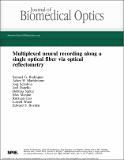| dc.contributor.author | Rodriques, Samuel Gordon | |
| dc.contributor.author | Marblestone, Adam Henry | |
| dc.contributor.author | Scholvin, Jorg | |
| dc.contributor.author | Dapello, Joel | |
| dc.contributor.author | Sarkar, Deblina | |
| dc.contributor.author | Mankin, Max | |
| dc.contributor.author | Gao, Ruixuan | |
| dc.contributor.author | Wood, Lowell | |
| dc.contributor.author | Boyden, Edward Stuart | |
| dc.date.accessioned | 2016-06-30T16:49:03Z | |
| dc.date.available | 2016-06-30T16:49:03Z | |
| dc.date.issued | 2016-05 | |
| dc.date.submitted | 2016-01 | |
| dc.identifier.issn | 1083-3668 | |
| dc.identifier.issn | 1560-2281 | |
| dc.identifier.uri | http://hdl.handle.net/1721.1/103386 | |
| dc.description.abstract | We introduce the design and theoretical analysis of a fiber-optic architecture for neural recording without contrast agents, which transduces neural electrical signals into a multiplexed optical readout. Our sensor design is inspired by electro-optic modulators, which modulate the refractive index of a waveguide by applying a voltage across an electro-optic core material. We estimate that this design would allow recording of the activities of individual neurons located at points along a 10-cm length of optical fiber with 40-μm axial resolution and sensitivity down to 100 μV using commercially available optical reflectometers as readout devices. Neural recording sites detect a potential difference against a reference and apply this potential to a capacitor. The waveguide serves as one of the plates of the capacitor, so charge accumulation across the capacitor results in an optical effect. A key concept of the design is that the sensitivity can be improved by increasing the capacitance. To maximize the capacitance, we utilize a microscopic layer of material with high relative permittivity. If suitable materials can be found—possessing high capacitance per unit area as well as favorable properties with respect to toxicity, optical attenuation, ohmic junctions, and surface capacitance—then such sensing fibers could, in principle, be scaled down to few-micron cross-sections for minimally invasive neural interfacing. We study these material requirements and propose potential material choices. Custom-designed multimaterial optical fibers, probed using a reflectometric readout, may, therefore, provide a powerful platform for neural sensing. | en_US |
| dc.description.sponsorship | Hertz Foundation | en_US |
| dc.description.sponsorship | National Science Foundation (U.S.) (Graduate Research Fellowship Program) | en_US |
| dc.description.sponsorship | National Institutes of Health (U.S.) (NIH Director’s Pioneer Award) | en_US |
| dc.description.sponsorship | National Institutes of Health (U.S.) (NIH grant 1U01MH106011) | en_US |
| dc.description.sponsorship | National Institutes of Health (U.S.) (NIH grant 1R24MH106075-01) | en_US |
| dc.language.iso | en_US | |
| dc.publisher | SPIE | en_US |
| dc.relation.isversionof | http://dx.doi.org/10.1117/1.jbo.21.5.057003 | en_US |
| dc.rights | Article is made available in accordance with the publisher's policy and may be subject to US copyright law. Please refer to the publisher's site for terms of use. | en_US |
| dc.source | SPIE | en_US |
| dc.title | Multiplexed neural recording along a single optical fiber via optical reflectometry | en_US |
| dc.type | Article | en_US |
| dc.identifier.citation | Rodriques, Samuel G., Adam H. Marblestone, Jorg Scholvin, Joel Dapello, Deblina Sarkar, Max Mankin, Ruixuan Gao, Lowell Wood, and Edward S. Boyden. “Multiplexed Neural Recording Along a Single Optical Fiber via Optical Reflectometry.” Journal of Biomedical Optics 21, no. 5 (May 19, 2016): 057003. | en_US |
| dc.contributor.department | Massachusetts Institute of Technology. Department of Biological Engineering | en_US |
| dc.contributor.department | Massachusetts Institute of Technology. Department of Brain and Cognitive Sciences | en_US |
| dc.contributor.department | Massachusetts Institute of Technology. Department of Physics | en_US |
| dc.contributor.department | Massachusetts Institute of Technology. Media Laboratory | en_US |
| dc.contributor.department | McGovern Institute for Brain Research at MIT | en_US |
| dc.contributor.mitauthor | Rodriques, Samuel Gordon | en_US |
| dc.contributor.mitauthor | Marblestone, Adam Henry | en_US |
| dc.contributor.mitauthor | Scholvin, Jorg | en_US |
| dc.contributor.mitauthor | Dapello, Joel | en_US |
| dc.contributor.mitauthor | Sarkar, Deblina | en_US |
| dc.contributor.mitauthor | Gao, Ruixuan | en_US |
| dc.contributor.mitauthor | Boyden, Edward Stuart | en_US |
| dc.relation.journal | Journal of Biomedical Optics | en_US |
| dc.type.uri | http://purl.org/eprint/type/JournalArticle | en_US |
| eprint.status | http://purl.org/eprint/status/PeerReviewed | en_US |
| dspace.orderedauthors | Rodriques, Samuel G.; Marblestone, Adam H.; Scholvin, Jorg; Dapello, Joel; Sarkar, Deblina; Mankin, Max; Gao, Ruixuan; Wood, Lowell; Boyden, Edward S. | en_US |
| dspace.embargo.terms | N | en_US |
| dc.identifier.orcid | https://orcid.org/0000-0002-9662-1666 | |
| dc.identifier.orcid | https://orcid.org/0000-0002-6574-097X | |
| dc.identifier.orcid | https://orcid.org/0000-0002-2509-0861 | |
| dc.identifier.orcid | https://orcid.org/0000-0002-0419-3351 | |
| dc.identifier.orcid | https://orcid.org/0000-0003-4167-440X | |
| mit.license | PUBLISHER_POLICY | en_US |
| mit.metadata.status | Complete | |
